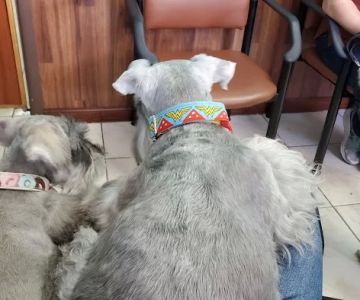Training a Dog to Be Comfortable with Grooming
As a dog owner, one of the challenges I faced early on was getting my dog, Charlie, to enjoy grooming. Charlie is a high-energy dog, and while he loves running and playing outside, he’s always been wary of the grooming tools. Whether it’s brushing, nail trimming, or bathing, grooming became a stressful experience for both of us. But after some time and patience, I learned how to train Charlie to be more comfortable with grooming. I’m here to share the journey and tips I used to make grooming a positive experience for him, and I hope it helps other pet owners who are struggling with the same issue.
1. Understanding Why Dogs Fear Grooming
The first step in training a dog to be comfortable with grooming is understanding why they may fear it in the first place. It turns out that many dogs, like Charlie, have a natural aversion to grooming because they associate it with uncomfortable or unfamiliar sensations. In some cases, the sound of clippers, the sensation of being brushed, or even the water from a bath can be unsettling for a dog.
For Charlie, I realized that his fear stemmed from past experiences with rough handling at the grooming salon. The tools used during grooming might also be too large or intimidating for some dogs, which can cause anxiety. By understanding the root cause of his discomfort, I could begin to take steps to ease his fear and make the process more manageable.

3480 Wilkes Barre Twp Commons, Wilkes-Barre, PA 18702, USA
See Details2. Start with Gradual Introduction
One of the first things I learned was that patience is key. You can’t expect your dog to immediately enjoy being groomed, especially if they’re scared of it. I started by gradually introducing Charlie to the grooming tools. At first, I let him simply see and smell the brushes, combs, and clippers. I didn’t attempt to use them on him at this point—I just wanted him to get used to their presence.
Next, I started using the brush on Charlie, but only for a few seconds at a time. I made sure to reward him with treats and positive reinforcement after every short session. The idea was to associate the grooming tools with something positive, so Charlie would start to feel more comfortable when he saw them. I always made sure to keep the sessions short and stress-free, gradually increasing the time as he became more relaxed.
3. Use Positive Reinforcement
Positive reinforcement played a huge role in training Charlie to tolerate grooming. Each time I groomed him, I made sure to give him a treat or some praise immediately afterward. For example, when I brushed him for a few seconds, I’d reward him with a favorite treat or a belly rub. This reward system helped Charlie associate grooming with good things, rather than something to be feared.
Eventually, I found that Charlie started looking forward to grooming sessions because he knew there would be a treat afterward. This also helped reduce his anxiety, and grooming became a more enjoyable experience for both of us. The key here is to stay consistent and patient, gradually increasing the duration of grooming as your dog becomes more comfortable.
4. Desensitize to Bath Time
Bath time can be one of the most stressful parts of grooming, especially for dogs who don’t like water. I found that Charlie’s fear of baths was linked to the sensation of water on his fur, so I took a gradual approach to desensitize him. At first, I simply introduced him to the bath area, allowing him to explore it without any water. I didn’t try to bathe him right away. Instead, I let him get comfortable with the environment.
Once he was relaxed with the bathroom area, I introduced the sound of running water. I made sure to keep the water temperature comfortable for him and used a gentle, dog-friendly showerhead. I started with just a few drizzles of water on his paws and worked my way up. Again, I used treats and praise to reward Charlie for staying calm during each step of the process. Over time, I was able to bathe him without the drama, and he even began to enjoy the process!
5. Nail Trimming Without the Drama
Nail trimming was one of the biggest challenges for me. At first, Charlie would squirm and pull away whenever I tried to trim his nails, making the task nearly impossible. I learned that the key to success was to start slow and build trust. I began by gently touching Charlie’s paws and giving him treats as rewards, slowly desensitizing him to the sensation of having his paws handled.
Once he was comfortable with his paws being touched, I introduced the nail clippers. I didn’t try to trim his nails immediately; instead, I just let him see and sniff the clippers first. After a few days of getting used to the sight of the clippers, I started by clipping just the very tip of one nail, followed by a treat and praise. I gradually worked up to trimming more nails, always rewarding Charlie for staying calm and patient. Over time, he became more comfortable with nail trimming, and it’s no longer a stressful experience for either of us.
6. Keep Grooming Sessions Consistent
Consistency is crucial when training a dog to be comfortable with grooming. I found that grooming Charlie at regular intervals helped him get used to the routine. I made sure to groom him at least once a week, even if it was just a short brushing session. The more consistent I was, the more Charlie started to expect and enjoy grooming. Routine is comforting for dogs, and it helped him understand that grooming is simply a part of life.
In addition to weekly grooming sessions, I also made sure to incorporate different types of grooming, such as brushing, bathing, and nail trimming, into his routine. This variety kept things interesting for Charlie and prevented him from associating grooming with just one specific task that he may not enjoy.
7. When to Seek Professional Help
While I was able to train Charlie to be more comfortable with grooming, some dogs may still have intense fear or anxiety about grooming. If your dog is particularly fearful or aggressive during grooming, it might be time to seek help from a professional dog groomer or a trainer. A professional can guide you through the process and may have additional tips or techniques to make the experience less stressful for both you and your dog.
Additionally, if your dog’s fear of grooming is related to pain or health issues (such as joint pain or sensitive skin), it’s important to consult your veterinarian. In some cases, medical conditions can cause discomfort during grooming, and a vet will be able to address these issues and offer appropriate solutions.
Conclusion
Training your dog to be comfortable with grooming is an important part of responsible pet ownership. With patience, consistency, and positive reinforcement, you can help your dog overcome their fear of grooming tools and make the experience more enjoyable for both of you. I’ve found that grooming sessions with Charlie are no longer stressful—they’ve become a bonding experience that we both look forward to. If you’re struggling with grooming your dog, remember that it’s a gradual process, and with the right approach, you’ll both get there.










